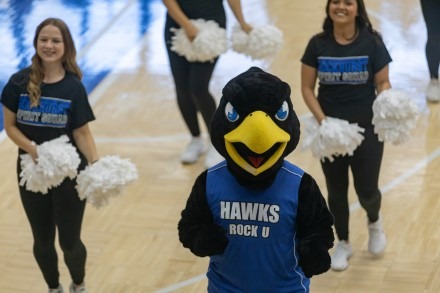Through Personal Writing, Ethnography and Instagram, English Students Tell Unique Stories of Pandemic Life

“Human first.”
That’s what the Post-It note on the laptop of Jameelah Lang, Ph.D., assistant professor of English, has told her for years.
It’s a reminder that teaching should always be student-focused — that above all else, her instruction should be a partnership with students that emphasizes their shared humanity and individual experiences.
That has felt more pressing or real since the COVID-19 pandemic hit. After the sudden switch to remote learning, Lang said she looked to her students to help shape what the rest of the semester looked like.
Before the pandemic, some of her students had already been reading pieces about trauma, memory and storytelling, but being confronted with a real-life, widespread trauma, Lang said she wasn’t sure students would wish to continue. Through surveys, the students indicated they did not want to shy away from their reality. They wanted to engage it head-on.
And having underscored experience and storytelling throughout her courses, Lang said that was reassuring.
“I think teaching is creating a place where my students can bring their experience,” she said. “I want my class to respond to the things they care about.”
Lang’s English 1110 and 1120 courses explored the pandemic in different ways, from documenting the stories of those affected by the pandemic across the globe to personal explorations of its effect on their own lives, in a variety of projects in different mediums. Students in the English 1110 course would normally be asked to find and follow a subculture to write an ethnography. Instead, they found subjects whom they could interview remotely about their experience during the pandemic. As a result, subjects came from as far as Brazil, and from every walk of life.
For the students in ENG 1120, the medium for one ongoing project was Instagram. Using a common profile on the photo and video sharing app, the class painted a picture of pandemic life — photos include going to work in a grocery store and video recipes for “mom’s nachos.” Through the experience, they grew closer, despite the physical distance.
“I feel our class has been able to build empathy towards each other and those around us within the Rockhurst community,” said Mackenzie Blair, a freshman nursing student. “I feel that our class has grown closer as a group and genuinely care for everyone’s wellbeing, even if we barely talked to each other when classes were face-to-face.”
In addition to bringing the students closer to each other, some said it also helped them feel connected to the campus community they missed.
“It makes the class feel more like it would on campus,” said freshman Sarah Hughes. “During this pandemic we need to remind each other that we are in this together and that everyone is feeling the same ways as us.”
To close the semester, they used what they learned about voice, identity and rhetoric to write letters to those who feel alone as a result of the pandemic. Lang said she put out a call, and students wrote more than 70 letters to strangers in the U.S., Ireland and Canada who needed someone to talk to, from as young as 4 years old to 86 years old.
Through those photos, videos, personal writings and COVID-19 ethnographies, the students have compiled a historical document of experiences in an unprecedented time. Lang said that illustrates the power of composition and its ability to communicate universal humanity through the perspective of the individual.
“Storytelling is our oldest artform. Since day one, we have been using it to share our experience, and that’s what we’ve been studying,” she said. “This is not about how to write a topic sentence — how to write a topic sentence is about how you tell the world who you are.”



